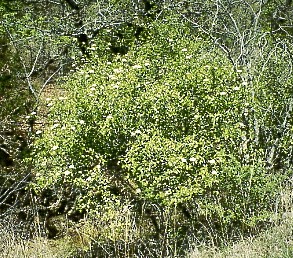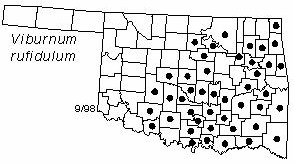
Small tree or large shrub, to 5 m (15 ft) tall and 15 cm (6 in) diameter. Bark rough, gray, divided into small rectangular plates. Twigs thin, rusty-hairy when young, becoming smooth and gray with age. Buds blunt, oblong, rusty-hairy, partially covered by a pair of scales. Leaves opposite, with short rusty-hairy petioles, elliptical, 5-10 cm (2-4 in) long and 3-6 cm (1.2-2.4 in) wide, finely serrate, dark shiny green above, rusty-hairy at least along the veins below, usually turning bright red in Fall. Flowers in upright terminal cymes to 15 cm (6 in) wide , numerous, small, white, blooming in Spring. Fruits in clusters of several at ends of branches, glaucous dark blue, about 15 mm (0.6 in) long, ripening in late Summer or early Fall.
Distribution: Native to about the southeastern quarter of the U. S.
Habitat: Forest understory, old fields, fencerows.
NWI status: FACU
Comment: This and other Viburnums are grown as ornamentals for their flowers and their bright Fall foliage. Viburnum is the old Latin name for some tree; rufidulum refers to the rusty-red hairs on the leaves and young twigs.
Distribution in Oklahoma: 
BACK
NEXT
RETURN TO INDEX
Last update: 9/22/99
 Go to Oklahoma Biological Survey Home Page
Go to Oklahoma Biological Survey Home Page
 Disclaimer
Disclaimer